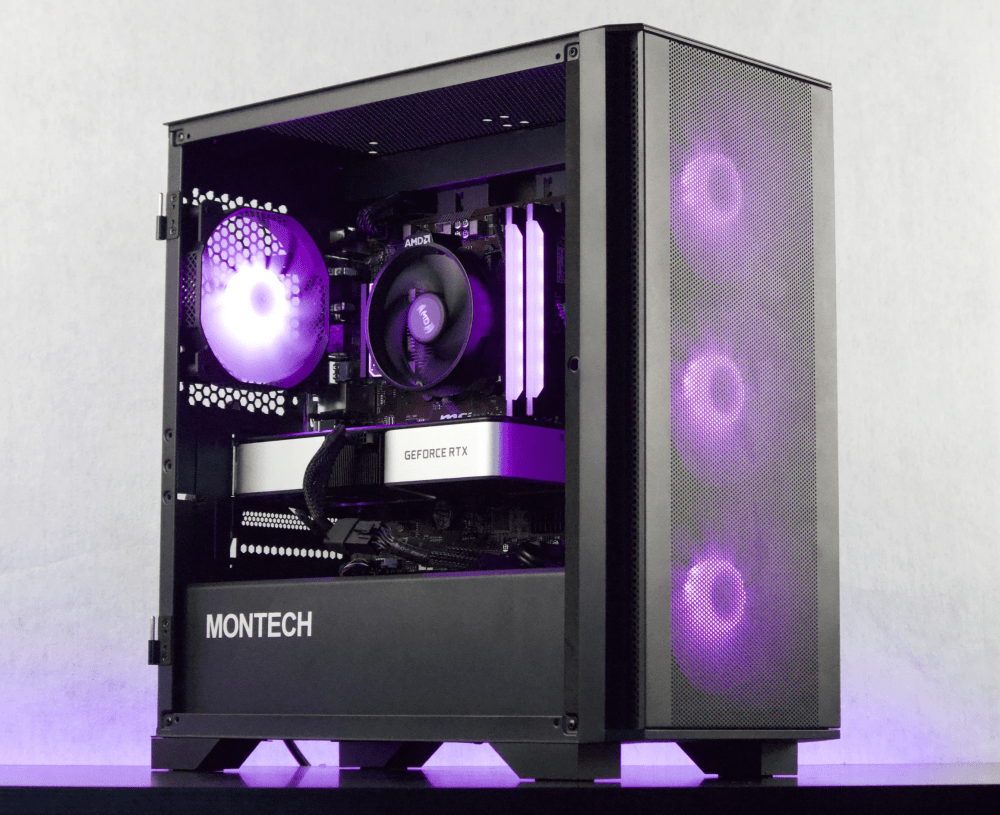Building a gaming PC is an exciting endeavor for any gaming enthusiast. The process allows you to customize your gaming rig to meet your specific needs, ensuring optimal performance and an immersive gaming experience. However, one question that often arises is, "How long does it take to build a gaming PC?"
In this blog post, we will explore the various stages involved in building a gaming PC and provide an estimate of the time it typically takes to complete each stage. From the preparation stage, where you plan and gather the necessary components, to the assembly stage, where you put everything together, and finally, to the setup and testing stage, where you install the operating system and ensure everything is functioning correctly.
We will delve into the importance of planning and understanding the basic components required for a gaming PC, as well as the tools you will need for the assembly process. We will also discuss the steps involved in assembling the PC, potential issues that may arise during assembly, and how to troubleshoot them effectively.
Additionally, we will explore the time frame required for the assembly stage, taking into account factors such as experience level and complexity of the build. Setting up and testing the gaming PC is equally vital, and we will guide you through the process of installing the operating system, drivers, and testing the performance of your newly built rig. We will also provide an estimated time for this stage.
Lastly, we will touch upon the importance of regular maintenance and software updates to keep your gaming PC running smoothly. We will also discuss the possibility of upgrading hardware components over time to enhance performance.
Whether you are a novice or an experienced builder, this blog post aims to provide you with a comprehensive understanding of the time it takes to build a gaming PC. So, let's dive in and explore the processes involved in creating the gaming rig of your dreams.
Understanding the Basics of Building a Gaming PC
Building a gaming PC requires a solid understanding of the basic components and their functions. Before diving into the construction process, it is essential to familiarize yourself with these components to ensure you make informed decisions during the building process.
Central Processing Unit (CPU)
The CPU, often referred to as the brain of the computer, handles all the calculations and processes necessary for the PC to function. Understanding the different CPU models, their clock speeds, and the number of cores can help you select the right CPU for your gaming needs.
Graphics Processing Unit (GPU)
The GPU is responsible for rendering graphics and images on your gaming PC. It plays a crucial role in delivering smooth gameplay and stunning visuals. Familiarize yourself with different GPU models, memory capacities, and performance benchmarks to make an informed decision.
Random Access Memory (RAM)
RAM is the temporary storage space that your PC uses to run applications and games. The amount of RAM you choose will determine how many programs you can run simultaneously and the overall performance of your gaming PC.
Storage Options
Understanding the different storage options, such as Solid State Drives (SSD) and Hard Disk Drives (HDD), is crucial for storing your operating system, games, and other files. SSDs offer faster load times, while HDDs provide more storage capacity at a lower cost.
Motherboard
The motherboard acts as the central hub that connects all the components of your gaming PC. It is crucial to select a motherboard that is compatible with your chosen CPU and has the necessary expansion slots and ports for your needs.
Power Supply Unit (PSU)
The PSU is responsible for supplying power to all the components of your gaming PC. Choosing a PSU with sufficient wattage and efficiency ensures stable and reliable power delivery.
Cooling System
Adequate cooling is essential to prevent overheating and ensure optimal performance of your gaming PC. Understanding the different cooling options, such as air cooling or liquid cooling, and selecting the appropriate cooling solution for your build is crucial.
By understanding the basics of these components, you will be better equipped to make informed decisions when selecting the right components for your gaming PC. This knowledge will ultimately contribute to a more efficient and successful building process.
Preparation Stage for Building a Gaming PC
Before diving into the assembly process, proper preparation is crucial to ensure a smooth and successful build. This stage involves several important steps, including planning, compiling a list of necessary components, and gathering the right tools for the job.
Why Planning is Essential
Planning is a fundamental aspect of building a gaming PC. It involves determining your budget, understanding your gaming needs, and setting realistic expectations. Proper planning helps you make informed decisions regarding the components you choose, ensuring compatibility and optimal performance.
List of Necessary Components
Creating a comprehensive list of the components you will need is essential to avoid any last-minute surprises or delays during the build. The list typically includes the CPU, GPU, RAM, storage devices, motherboard, PSU, cooling system, and other peripherals such as a keyboard, mouse, and monitor.
Choosing the Right Tools
Having the right tools at your disposal can significantly simplify the building process. Some essential tools include a screwdriver set, thermal paste, cable ties, an anti-static wristband, and a clean, well-lit workspace. Ensuring you have all the necessary tools beforehand will help prevent interruptions and streamline the building process.
By adequately preparing for the build, you can minimize the chances of encountering unexpected challenges or delays during the assembly process. This stage sets the foundation for a successful and hassle-free gaming PC build.
Assembling the Gaming PC
Once you have completed the preparation stage, it's time to move on to the exciting part: assembling your gaming PC. This section will guide you through the step-by-step process of putting all the components together to create a functional gaming rig.
Steps to Install the Components
- Begin by installing the CPU onto the motherboard, ensuring correct alignment and applying thermal paste if required.
- Install the CPU cooler, either an air cooler or liquid cooler, following the manufacturer's instructions.
- Insert the RAM modules into the appropriate slots on the motherboard.
- Mount the motherboard into the PC case, aligning the screw holes and securing it in place.
- Install the power supply unit (PSU) into the case and connect the necessary cables to the motherboard and other components.
- Connect the storage devices, such as SSDs or HDDs, to the motherboard using the appropriate cables.
- Install the graphics card (GPU) into the PCIe slot on the motherboard and secure it firmly.
- Connect all necessary cables, including power cables and data cables, to the respective components.
- Install any additional expansion cards, such as sound cards or Wi-Fi cards, if desired.
- Finally, tidy up the cables inside the case using cable ties or a cable management system for better airflow and aesthetics.
Possible Issues During Assembly and How to Solve Them
During the assembly process, you may encounter certain issues or challenges. Some common problems include compatibility issues, improper seating of components, or difficulties with cable management. Here are a few troubleshooting tips to help you overcome these hurdles:
- Ensure that all components are compatible with each other and properly seated.
- Double-check all cable connections to ensure they are secure and in the correct slots.
- Pay attention to any error messages or beeps from the motherboard, as they can indicate potential issues.
- Refer to the instruction manuals and online resources for specific troubleshooting guidance related to your components.
Time Frame to Complete the Assembly
The time required to assemble a gaming PC can vary depending on several factors, including your experience level, the complexity of the build, and the efficiency of your workspace. On average, it can take anywhere from a few hours to a full day to complete the assembly process. It is important to allocate enough time to work carefully and methodically, ensuring that all components are installed correctly.
By following the step-by-step instructions and troubleshooting tips provided, you can confidently assemble your gaming PC and move on to the next stage of the process: setting up and testing your newly built rig.
Setting Up and Testing the Gaming PC
After successfully assembling your gaming PC, the next step is to set it up and ensure that all components are functioning correctly. This section will guide you through the process of installing the operating system, drivers, and testing the performance of your newly built rig.
How to Install the Operating System and Drivers
- Begin by inserting the installation media (such as a USB drive or DVD) containing the operating system (e.g., Windows, macOS, or Linux) into the appropriate drive.
- Follow the on-screen instructions to boot from the installation media and install the operating system onto your storage device.
- Once the operating system is installed, proceed to install the necessary drivers for your components. This includes drivers for the motherboard, GPU, sound card, and other peripherals, which can be obtained from the manufacturers' websites or through automatic driver update software.
Testing the Performance of the PC
To ensure that your gaming PC is running optimally, it is vital to test its performance. Here are a few ways to evaluate its capabilities:
-
Benchmarking: Use benchmarking software, such as 3DMark or Geekbench, to measure the performance of your CPU, GPU, and overall system. Compare the results to similar systems to determine if your PC is performing as expected.
-
Stress Testing: Run stress testing software, like Prime95 or FurMark, to put your CPU and GPU under heavy load. This will help identify any stability issues or overheating problems that may arise during intense gaming sessions.
-
Game Testing: Install and play a variety of demanding games to gauge the performance of your gaming PC. Monitor factors such as frame rates, load times, and overall gameplay smoothness to ensure a satisfactory gaming experience.
Expected Time for Setup and Testing
The time required to set up and test your gaming PC will vary depending on factors such as the operating system installation process, the number of drivers that need to be installed, and the duration of the performance testing. On average, this stage can take several hours to complete thoroughly. It is essential to allocate enough time to ensure all necessary software is installed correctly, drivers are up to date, and performance testing is conducted adequately.
By following the steps outlined in this section, you can set up your gaming PC and ensure that it is running smoothly, ready to provide you with an exceptional gaming experience.
Maintaining Your Gaming PC
Maintaining your gaming PC is vital to ensure its longevity and optimal performance. This section will cover the essential aspects of PC maintenance, including regular cleaning and inspection, updating software, and the possibility of upgrading hardware components over time.
Regular Cleaning and Inspection
- Dusting: Dust accumulation can lead to overheating and reduced performance. Regularly clean the exterior of your PC case using a soft cloth or compressed air. Pay special attention to vents, fans, and filters.
- Internal Cleaning: Periodically open the case and clean the internal components. Use compressed air to remove dust from the motherboard, CPU cooler, GPU, and other areas. Be cautious and avoid touching sensitive parts.
- Cable Management: Check and tidy up the cables inside the case to maintain proper airflow and prevent cable interference.
Updating Your Software Regularly
- Operating System Updates: Enable automatic updates or regularly check for updates to your operating system. These updates often include security patches and performance improvements.
- Driver Updates: Visit the manufacturers' websites or use driver update software to ensure your drivers are up to date. Updated drivers can enhance compatibility and resolve any issues with your components.
Upgrading Hardware Components Over Time
- Graphics Card: Graphics card technology advances rapidly. Consider upgrading your GPU to keep up with the demands of new games and improved graphics capabilities.
- RAM: If you find your system struggling with memory-intensive tasks or newer games, upgrading your RAM can improve overall performance.
- Storage: Upgrading to a faster SSD or increasing storage capacity can enhance load times and provide more room for games and files.
- CPU and Motherboard: Upgrading your CPU and motherboard can significantly boost performance, but it may require additional considerations, such as compatibility with other components.
By regularly maintaining your gaming PC and staying updated with software and hardware upgrades, you can ensure that your system remains in excellent condition and is capable of handling the latest games and applications. Remember to research and consult with experts or forums for specific recommendations before making any significant hardware upgrades.
Want to get a great PC at a killer price? Check out gaming PCs at Jawa, the marketplace for gamers





